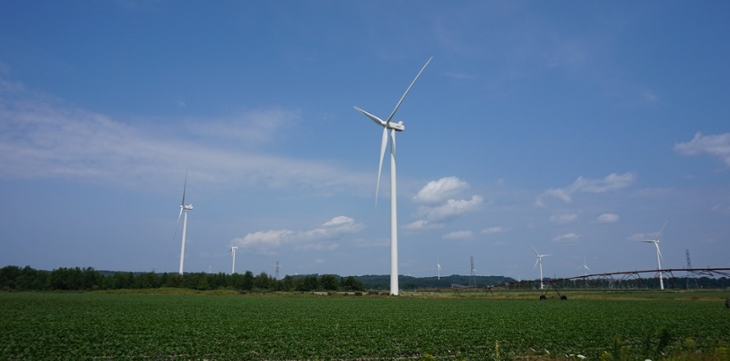
Photo by Drew Buikema, used under a Creative Commons license.
Back in December 2016, an omnibus energy bill signed into law in Michigan contained a small section requiring utilities to develop “voluntary green pricing” programs. Today, nearly two years later, the ensuing regulatory process is producing results that will open new renewable energy options for residential as well as commercial and industrial (C&I) customers. The Michigan Public Service Commission recently issued orders requiring improvements to Consumers Energy’s “Large Customer Renewable Energy Program” (LC-REP) and Solar Gardens program, and to DTE’s MIGreenPower program, while also requiring DTE to introduce a new program focused on C&I customers. The regulatory process is far from complete, but before long corporate customers in Michigan will have more and better ways to procure the renewable energy they want to power their operations.
Before we dive into the Commission’s orders and DTE’s new proposed program, let’s cover the history of how we got here. Section 61 of Act 342, enacted in 2016, required utilities to provide a “voluntary green pricing program under which the customer may specify, from the options made available by the electric provider, the amount of electricity attributable to the customer that will be renewable energy.” The Michigan Public Service Commission, recognizing that the statute did not provide “any detail concerning the elements these green pricing programs should include or how the Commission should evaluate green pricing proposals,” initiated a process to solicit input from stakeholders on exactly those questions.
AEE and the Michigan Energy Innovation Business Council (Michigan EIBC), AEE’s partner in the state, jointly provided comments and reply comments in that process, focusing in particular on the needs of C&I customers, as well as a quantification of potential C&I customer demand. In July 2017, the Commission issued guidelines for utility applications, which responded to many of the recommendations from stakeholders, including an emphasis on the importance of providing a “menu of options” to meet the needs of different customers.
In October 2017, Michigan utilities filed applications to comply with Section 61, with the state’s major utilities proposing to maintain the status quo. Specifically, DTE proposed to keep its existing MIGreenPower program as it is, and Consumers made the case that its SolarGardens and LC-REP programs met the requirements of the statute as they were.
While approving applications from the smaller Michigan utilities, the Commission turned DTE’s and Consumer’s filings into contested cases. AEE and Michigan EIBC, along with the nonprofit Institute for Energy Innovation, intervened in both to make the case for improvements to meet the needs of more customers.
In October 2018, the Commission gave Consumers’ application conditional approval, while DTE’s application was rejected, noting several requirements that would be needed for DTE’s programs to pass muster. Here are the highlights, focused on items we emphasized in each case:
- The Commission found DTE’s MIGreenPower Program to be too small and too expensive. The Commission cited the high cost of the program and its limited size—two failings that we pointed out —and required the utility to either improve or replace the program.
- The Commission required DTE to develop a new C&I program. Recognizing the inadequacy of the MIGreenPower program to serve a range of customers—especially C&I customers, a point we made vigorously in our testimony and brief in the case—the Commission required the utility to develop a new program that would give customers a “menu of options.”
- The Commission required Consumers to expand both of its programs to accommodate more customers. Consumers had indicated that it was not planning to add additional resources to its LC-REP program, which, as we pointed out in our testimony, was nearly fully subscribed by just two customers, General Motors and Switch. The Commission’s order ensures that this program and the SolarGardens community solar program will be available to additional customers.
- The Commission required Consumers to clarify that customers could aggregate meters under the LC-REP program. The ability to aggregate meters is key to ensure that customers with large but distributed loads are not excluded from participating. Consumers has already filed these revisions.
- The Commission did not require Consumers to offer more contract term options for customers. Under LC-REP Option A, customers have to choose between two term options: three years or 20 years. We argued in our testimony and brief that most customers want options in the 10-15 year range. However, the Commission did acknowledge this concern and said it would look at the issue during its review of the program starting in October 2019.
- The Commission also initiated a stakeholder process to explore barriers to third-party community renewable energy projects. This process is intended to ensure that such programs are competitively priced to better meet customer needs.
In response to the Commission’s order, DTE has filed its proposed new “Large Customer Voluntary Green Pricing Program” and it’s a huge improvement over MIGreenPower—and much better suited to the needs of C&I customers. The program has a market-based cost and credit structure that appears to be competitively priced; does not assign excessive marketing and administrative fees; allows customers to select five-, 10-, or 20-year terms; provides clear and reasonable termination provisions; and is designed to scale with customer demand. Consumers has also made an initial filing for expansion of its Solar Gardens and LC-REP programs.
In the months ahead, we’ll participating in the stakeholder process to explore barriers to third-party community renewable energy projects. And we’ll be following closely as DTE’s new C&I program and Consumers’ program expansion work their way through the regulatory process. It may be a long and winding road, but Michigan is on its way to making renewable energy available to more corporate customers than ever before.
Laura Sherman is vice president for policy development at Michigan EIBC.
A report from AEE Institute, "Making Corporate Renewable Energy Purchasing Work for All Utility Customers," and a companion policy brief from AEE provide guidance for the design of successful renewable energy programs in regulated markets.
